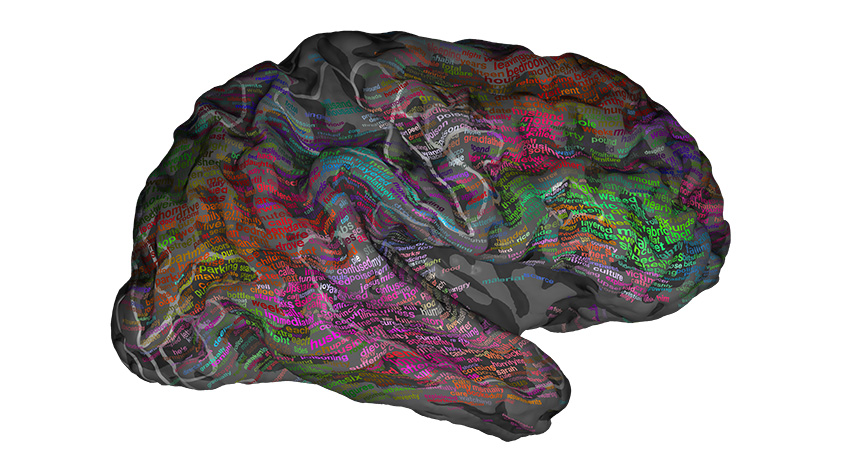Mapping word meanings in the brain
People understand language by using tissues all across the brain, not just in one region

The brain areas that respond to word meanings speckle much of the cerebral cortex, that wrinkly outer layer of the brain.
ALEXANDER HUTH, PYCORTEX SOFTWARE BY JAMES GAO, MARK LESCROART AND A. HUTH
By Meghan Rosen
Language doesn’t live in just one part of the brain. Instead, many different brain regions pick out the meanings of words. These areas exist all across the brain’s wrinkly outer layer, new data show.
One brain region, for instance, responds to the words “family,” “home” and “mother.” It sits in a tiny chunk of tissue on the right side of the brain, above and behind the ear. A complex new map revealed that area and others. The map charts hundreds of brain areas that respond to words.
Scientists described this new map in a paper published online April 27 in Nature.
Russell Poldrack was not involved in the work. A neuroscientist at Stanford University, in California, he studies the brain’s structures and how they work. The detailed new map, he says, hints that the way people understand language is much more complicated than scientists had thought. Understanding words also involves many more brain areas than scientists had expected.
In fact, Poldrack says, “these data suggest we need to rethink how the brain organizes meaning.”
Jack Gallant is a computational neuroscientist at the University of California, Berkeley. He also is an author of the new study. Scientists knew that different concepts turn on activity in different parts of the brain, he notes. But most thought that big hunks of the brain handled separate concepts. For example, there might be one big region for concepts related to vision, and another for concepts related to emotion. And the brain’s left hemisphere, or side, was thought to be most important for language.
Earlier studies had tested just single words or sentences, Gallant says. And they made only rough estimates of where those meanings showed up in the brain. That’s like looking at the world’s countries in Google maps, instead of zooming in to the street view.
So Gallant and his team mapped the activity of about 60,000 to 80,000 pea-sized brain regions. They are scattered all across the brain’s outer layer, known as the cortex. As their brains were scanned, the research volunteers lay in a functional magnetic resonance imaging (fMRI) machine. While they did that, they listened to stories from The Moth Radio Hour. (This program features people telling personal tales to a live audience.)
“People actually love this experiment,” Gallant says.
The study stands out from others because the authors used “real life, complicated stories,” says Uri Hasson. He’s a Princeton University neuroscientist who was not involved in the research. “That’s really meaningful to see how the brain operates.”
Gallant’s team used a computer program to identify the concepts in every 1- to 2-second snippet of the stories. By observing which brain areas lit up in each moment, they could map where 985 of the stories’ concepts appear in the brain.
Word meanings didn’t just activate the left hemisphere, the team found. They switched on groups of nerve cells spread broadly across the brain’s outer surface.
After mapping where meanings were represented in the brain, the researchers figured out where individual words might show up. Often, the same word appeared in more than one location. For instance, the word “top” turned up in a brain region with clothing words. It also emerged in an area related to numbers and measurements.
The brain maps of the seven study participants looked remarkably similar. That could be due to their shared life experiences, Gallant says. All seven people grew up and went to school in Western societies. And with so few people, the researchers can’t pick out any gender differences, he says. Ideally he’d like to repeat the experiment with 50 or 100 people.
For now, Gallant hopes the map can be a resource for other scientists. One day, the work might help scientists decode the words in a person’s unspoken thoughts. That could help people who have amyotrophic lateral sclerosis (also known as Lou Gehrig’s disease) or other conditions that keep people from communicating. But the map is just one piece of the puzzle, Gallant says. Researchers also would need a tool for measuring brain activity that’s portable, something today’s MRI machines are not.
Power Words
(for more about Power Words, click here)
amyotrophic lateral sclerosis (or ALS) A disease that attacks and progressively kills motor nerve cells over time. These cells control the movements of many muscle groups. As the motor nerve cells die, people with ALS lose their ability to speak, walk and swallow. ALS is also sometimes called Lou Gehrig’s disease after the baseball player who was stricken with this disease.
cerebral cortex The outermost layer of neural tissue covering the front part of a vertebrate animal’s brain.
computational neuroscience A field in which scientists use mathematics and computer programs to better understand structures in the brain and what they do.
fMRI (functional magnetic resonance imaging) A special type of machine used to study brain activity. It uses a strong magnetic field to monitor blood flow in the brain. Tracking the movement of blood can tell researchers which brain regions are active.
hemisphere Half of a globe, which can refer to half of the Earth, half of some ball, or anything else — such as half of the brain.
neuroscience Science that deals with the structure or function of the brain and other parts of the nervous system. Researchers in this field are known as neuroscientists.







